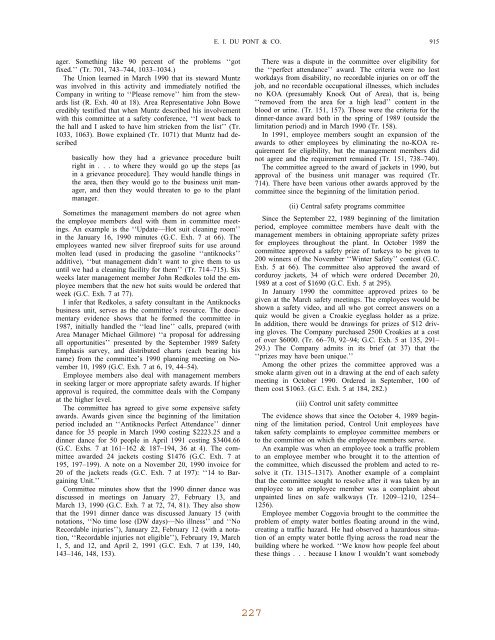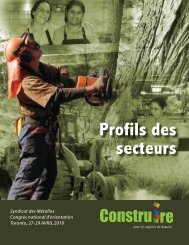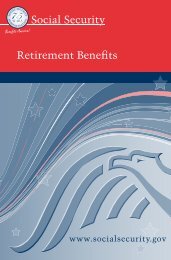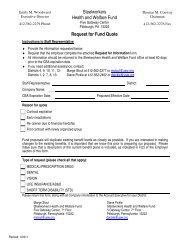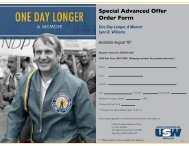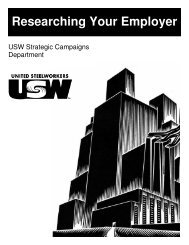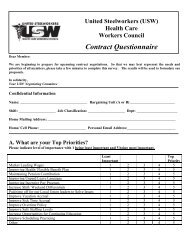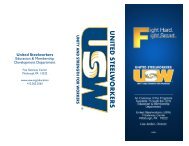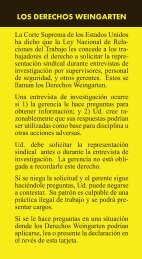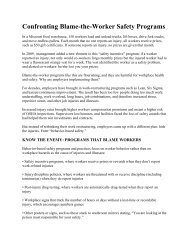Union Approach to Health and Safety: - United Steelworkers
Union Approach to Health and Safety: - United Steelworkers
Union Approach to Health and Safety: - United Steelworkers
You also want an ePaper? Increase the reach of your titles
YUMPU automatically turns print PDFs into web optimized ePapers that Google loves.
E. I. DU PONT & CO.<br />
915<br />
ager. Something like 90 percent of the problems ‘‘got<br />
fixed.’’ (Tr. 701, 743–744, 1033–1034.)<br />
The <strong>Union</strong> learned in March 1990 that its steward Muntz<br />
was involved in this activity <strong>and</strong> immediately notified the<br />
Company in writing <strong>to</strong> ‘‘Please remove’’ him from the stewards<br />
list (R. Exh. 40 at 18). Area Representative John Bowe<br />
credibly testified that when Muntz described his involvement<br />
with this committee at a safety conference, ‘‘I went back <strong>to</strong><br />
the hall <strong>and</strong> I asked <strong>to</strong> have him stricken from the list’’ (Tr.<br />
1033, 1063). Bowe explained (Tr. 1071) that Muntz had described<br />
basically how they had a grievance procedure built<br />
right in . . . <strong>to</strong> where they would go up the steps [as<br />
in a grievance procedure]. They would h<strong>and</strong>le things in<br />
the area, then they would go <strong>to</strong> the business unit manager,<br />
<strong>and</strong> then they would threaten <strong>to</strong> go <strong>to</strong> the plant<br />
manager.<br />
Sometimes the management members do not agree when<br />
the employee members deal with them in committee meetings.<br />
An example is the ‘‘Update—Hot suit cleaning room’’<br />
in the January 16, 1990 minutes (G.C. Exh. 7 at 66). The<br />
employees wanted new silver fireproof suits for use around<br />
molten lead (used in producing the gasoline ‘‘antiknocks’’<br />
additive), ‘‘but management didn’t want <strong>to</strong> give them <strong>to</strong> us<br />
until we had a cleaning facility for them’’ (Tr. 714–715). Six<br />
weeks later management member John Redkoles <strong>to</strong>ld the employee<br />
members that the new hot suits would be ordered that<br />
week (G.C. Exh. 7 at 77).<br />
I infer that Redkoles, a safety consultant in the Antiknocks<br />
business unit, serves as the committee’s resource. The documentary<br />
evidence shows that he formed the committee in<br />
1987, initially h<strong>and</strong>led the ‘‘lead line’’ calls, prepared (with<br />
Area Manager Michael Gilmore) ‘‘a proposal for addressing<br />
all opportunities’’ presented by the September 1989 <strong>Safety</strong><br />
Emphasis survey, <strong>and</strong> distributed charts (each bearing his<br />
name) from the committee’s 1990 planning meeting on November<br />
10, 1989 (G.C. Exh. 7 at 6, 19, 44–54).<br />
Employee members also deal with management members<br />
in seeking larger or more appropriate safety awards. If higher<br />
approval is required, the committee deals with the Company<br />
at the higher level.<br />
The committee has agreed <strong>to</strong> give some expensive safety<br />
awards. Awards given since the beginning of the limitation<br />
period included an ‘‘Antiknocks Perfect Attendance’’ dinner<br />
dance for 35 people in March 1990 costing $2223.25 <strong>and</strong> a<br />
dinner dance for 50 people in April 1991 costing $3404.66<br />
(G.C. Exhs. 7 at 161–162 & 187–194, 36 at 4). The committee<br />
awarded 24 jackets costing $1476 (G.C. Exh. 7 at<br />
195, 197–199). A note on a November 20, 1990 invoice for<br />
20 of the jackets reads (G.C. Exh. 7 at 197): ‘‘14 <strong>to</strong> Bargaining<br />
Unit.’’<br />
Committee minutes show that the 1990 dinner dance was<br />
discussed in meetings on January 27, February 13, <strong>and</strong><br />
March 13, 1990 (G.C. Exh. 7 at 72, 74, 81). They also show<br />
that the 1991 dinner dance was discussed January 15 (with<br />
notations, ‘‘No time lose (DW days)—No illness’’ <strong>and</strong> ‘‘No<br />
Recordable injuries’’), January 22, February 12 (with a notation,<br />
‘‘Recordable injuries not eligible’’), February 19, March<br />
1, 5, <strong>and</strong> 12, <strong>and</strong> April 2, 1991 (G.C. Exh. 7 at 139, 140,<br />
143–146, 148, 153).<br />
There was a dispute in the committee over eligibility for<br />
the ‘‘perfect attendance’’ award. The criteria were no lost<br />
workdays from disability, no recordable injuries on or off the<br />
job, <strong>and</strong> no recordable occupational illnesses, which includes<br />
no KOA (presumably Knock Out of Area), that is, being<br />
‘‘removed from the area for a high lead’’ content in the<br />
blood or urine. (Tr. 151, 157). Those were the criteria for the<br />
dinner-dance award both in the spring of 1989 (outside the<br />
limitation period) <strong>and</strong> in March 1990 (Tr. 158).<br />
In 1991, employee members sought an expansion of the<br />
awards <strong>to</strong> other employees by eliminating the no-KOA requirement<br />
for eligibility, but the management members did<br />
not agree <strong>and</strong> the requirement remained (Tr. 151, 738–740).<br />
The committee agreed <strong>to</strong> the award of jackets in 1990, but<br />
approval of the business unit manager was required (Tr.<br />
714). There have been various other awards approved by the<br />
committee since the beginning of the limitation period.<br />
(ii) Central safety programs committee<br />
Since the September 22, 1989 beginning of the limitation<br />
period, employee committee members have dealt with the<br />
management members in obtaining appropriate safety prizes<br />
for employees throughout the plant. In Oc<strong>to</strong>ber 1989 the<br />
committee approved a safety prize of turkeys <strong>to</strong> be given <strong>to</strong><br />
200 winners of the November ‘‘Winter <strong>Safety</strong>’’ contest (G.C.<br />
Exh. 5 at 66). The committee also approved the award of<br />
corduroy jackets, 34 of which were ordered December 20,<br />
1989 at a cost of $1690 (G.C. Exh. 5 at 295).<br />
In January 1990 the committee approved prizes <strong>to</strong> be<br />
given at the March safety meetings. The employees would be<br />
shown a safety video, <strong>and</strong> all who got correct answers on a<br />
quiz would be given a Croakie eyeglass holder as a prize.<br />
In addition, there would be drawings for prizes of $12 driving<br />
gloves. The Company purchased 2500 Croakies at a cost<br />
of over $6000. (Tr. 66–70, 92–94; G.C. Exh. 5 at 135, 291–<br />
293.) The Company admits in its brief (at 37) that the<br />
‘‘prizes may have been unique.’’<br />
Among the other prizes the committee approved was a<br />
smoke alarm given out in a drawing at the end of each safety<br />
meeting in Oc<strong>to</strong>ber 1990. Ordered in September, 100 of<br />
them cost $1063. (G.C. Exh. 5 at 184, 282.)<br />
(iii) Control unit safety committee<br />
The evidence shows that since the Oc<strong>to</strong>ber 4, 1989 beginning<br />
of the limitation period, Control Unit employees have<br />
taken safety complaints <strong>to</strong> employee committee members or<br />
<strong>to</strong> the committee on which the employee members serve.<br />
An example was when an employee <strong>to</strong>ok a traffic problem<br />
<strong>to</strong> an employee member who brought it <strong>to</strong> the attention of<br />
the committee, which discussed the problem <strong>and</strong> acted <strong>to</strong> resolve<br />
it (Tr. 1315–1317). Another example of a complaint<br />
that the committee sought <strong>to</strong> resolve after it was taken by an<br />
employee <strong>to</strong> an employee member was a complaint about<br />
unpainted lines on safe walkways (Tr. 1209–1210, 1254–<br />
1256).<br />
Employee member Coggovia brought <strong>to</strong> the committee the<br />
problem of empty water bottles floating around in the wind,<br />
creating a traffic hazard. He had observed a hazardous situation<br />
of an empty water bottle flying across the road near the<br />
building where he worked. ‘‘We know how people feel about<br />
these things . . . because I know I wouldn’t want somebody


